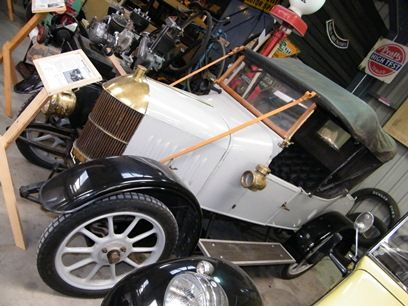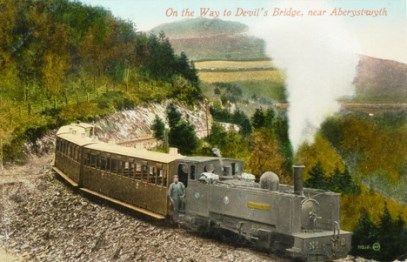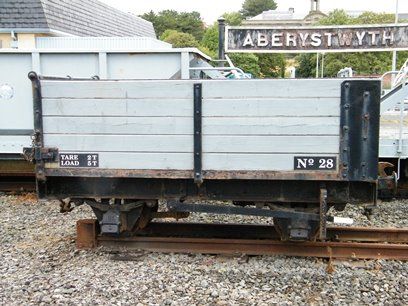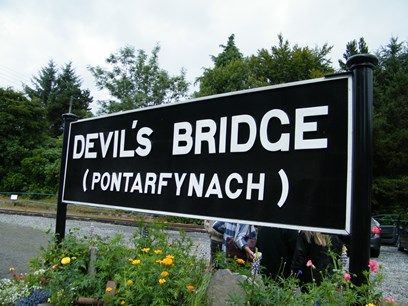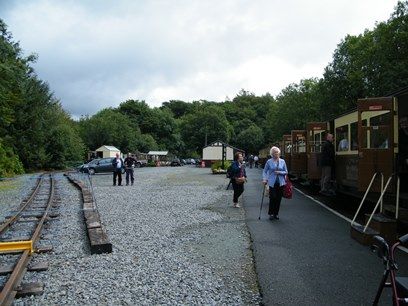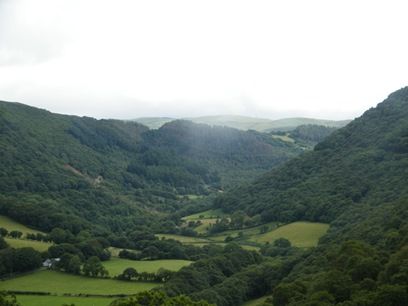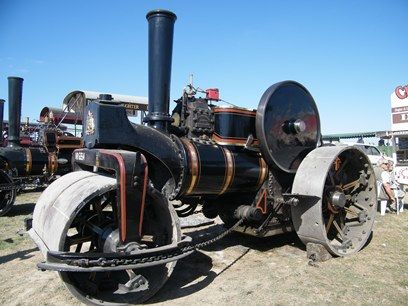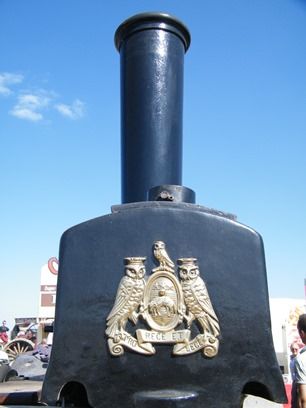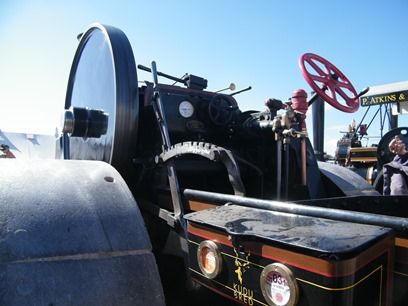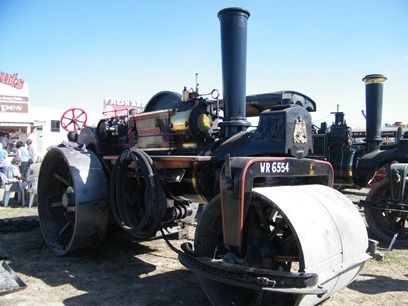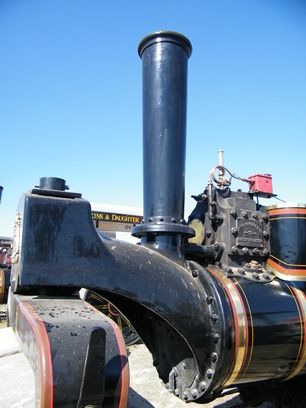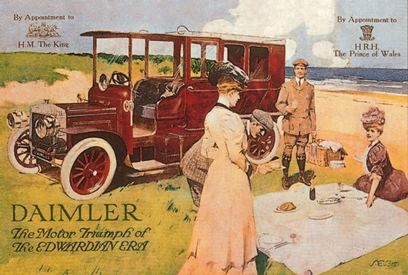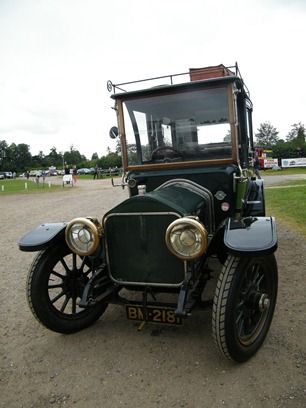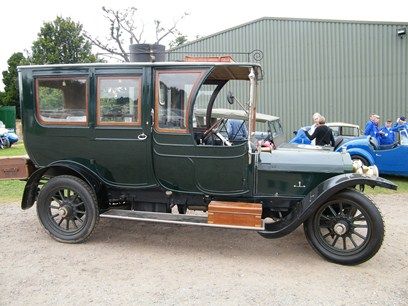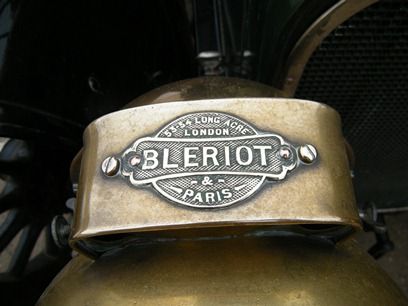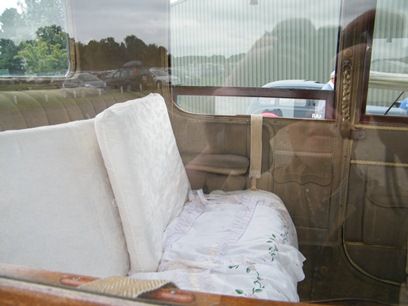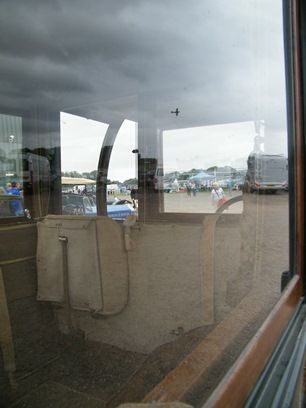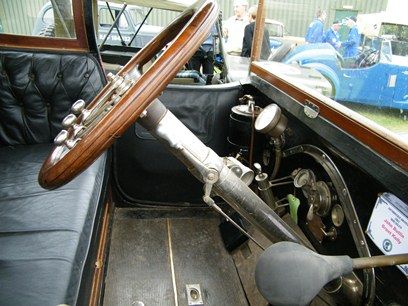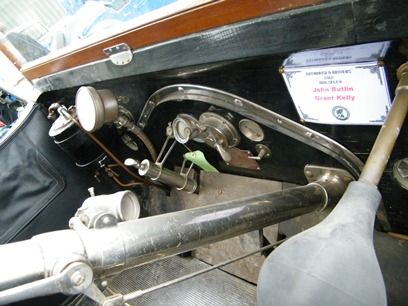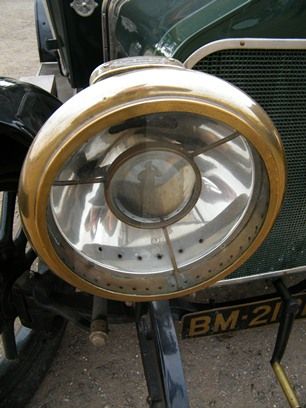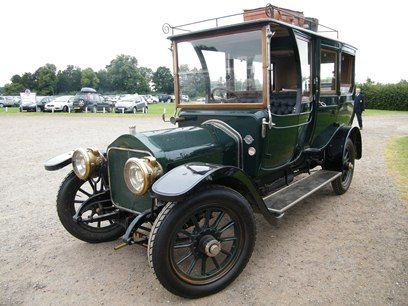This very pleasant little motor car, which was developed into what is popularly known as the 'Bullnose Morris', was built as the Morris Oxford, first produced in 1912 by William R Morris of Oxford (who later became Lord Nuffield). He wanted to copy Henry Ford and his famous Model T and produce a vehicle affordable for the average man on the street - to help keep costs down, the early models had the engine, clutch and gearbox built as one unit by White and Poppe. The design first appeared to the public at the Manchester Show of 1913 and was remarked upon for it's many attributes and design features more commonly associated with larger, and more expensive, cars - it was an immediate success, and over a thousand had been sold by the end of 1914. This two-seat Tourer is fitted with a 10hp, 1 litre engine, with a top speed of 55mph and a price when new of £180
A blog about the Edwardian era in the UK - objects, buildings, people, literature, film and all other aspects of the Edwardian era (covering 1901-1919)

Monday 14 October 2013
Thursday 10 October 2013
Vale of Rheidol Railway, 1902
Colourised postcard from my collection showing a passenger train hauled by No 2 'Prince of Wales' of 1901, photo taken c1904
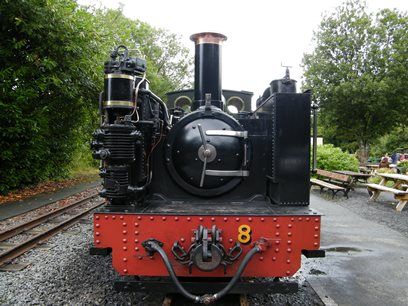

Original 1902 corrugated iron building at Devil's Bridge station
The Vale of Rheidol Railway is a narrow gauge railway, built a gauge of 1 ft, 11 3/4 inches between the rails, originally designed to carry timber and ore from the Rheidol valley down to the sea port at Aberystwyth, however by the time the railway was nearing completion these industries were in decline in the Rheidol valley, but the huge increase in tourism in the late 19th and early 20th century gave the railway another purpose - transporting tourists up to Devil's Bridge, a very scenic part of mid-Wales, featuring a waterfall and a bridge said to have been built by the Devil himself for a local woman, so her cows could cross - the Devil planning to take the soul of the first person to cross the bridge in exchange, hoping it would be her, leading the cows - she somehow discovered this and so threw bread over the bridge, and her dog ran over, making that the first soul to cross. In reality it was built in around the 9th century - there is another bridge, built in 1753, built over the original bridge, the builders using the original bridge as scaffolding, and a 1901 iron bridge crossing the lower two.
Construction of the line started in 1901 following the Act of Parliament allowing the line to be built being granted in 1897 - two locomotives were built by Davies & Metcalfe of Manchester, who hadn't built a locomotive before (or since), but did so because Metcalfe came from Aberystwyth, the locomotives having to be capable of working the impressive gradient up to Devil's Bridge, hugging the valley side. They were 2-6-2T side tank engines, with high, thin water tanks surrounding the boiler. These were No 1 and No 2, named 'King Edward VII' and 'Prince of Wales' respectively - King Edward VII coming to the throne in 1901 following the death of his mother, Queen Victoria, and Prince of Wales being the future King George V. No 3, 'Rheidol', was built by Bagnall of Stafford in 1896 for a Brazilian plantation but was never delivered, was regauged for use on the Plynlimon and Hafan Tramway, but when this failed was regauged again for the Vale of Rheidol who purchased it in 1903.
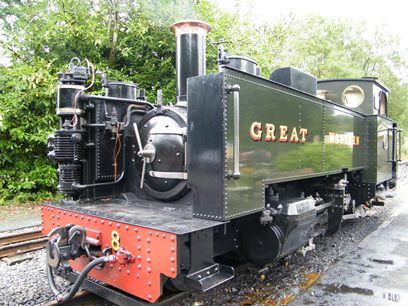
One of the three 1923 built locomotives, No 8, almost identical to the two original Vale of Rheidol locomotives
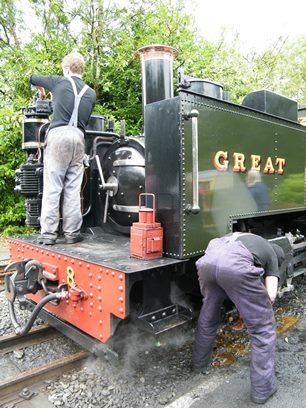
The crew of No 8 giving attention to the locomotive after the hard climb up to Devil's Bridge
The line was opened on 22nd December 1902, and did bring about an increase in trade in the previously declining industries in the Rheidol valley, and some mines even reopened. An aerial ropeway was opened from the Level Fawr Lead Mine to Rhiwfron station. The materials from the mine, and also the timber, would be shipped down to Aberystywth for onward transportation via standard gauge railway or the sea. The line was so successful that in 1912 electric motive power was even considered - however in the same year the line came under control of the Cambrian Railway, and two years later the First World War caused a decline in traffic. At some point between 1916 and 1918 the two Davies & Metcalfe 2-6-2T locomotives were modified with bigger coal bunkers, as the ones they were fitted with were very small. After the war, the decline in local industries continued, but the tourist trade grew. At the grouping in 1923, the line came under control of the Great Western Railway, who immediately built three new locomotives that year - externally they looked almost identical to the two Davies & Metcalfe locomotives, the most obvious difference being the lack of a cab side window. Officially, only two new locomotives were built, No 7 & No 8, as these were the only two new builds authorised by the Great Western Railway, and No 9 was officially a 'rebuild' of No 2 'Prince of Wales'. In actual fact this was just an accounting exercise and No 9 was a brand new locomotive like the other two. No 1 'King Edward VII' survived for a few more years until scrapping in the 1930s.
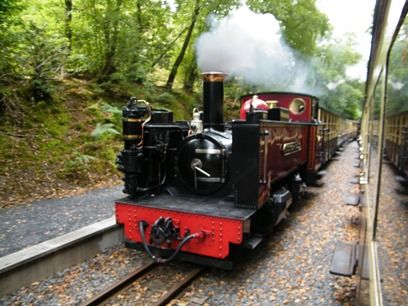
No 9, officially a rebuild of No 2 'Prince of Wales' of 1901, and indeed also being named 'Prince of Wales', and for many years recorded in books, magazines and online as being so, however research by CC Green who published a very comprehensive book on the Vale of Rheidol Railway proved that no parts between the two locomotives would be interchangeable
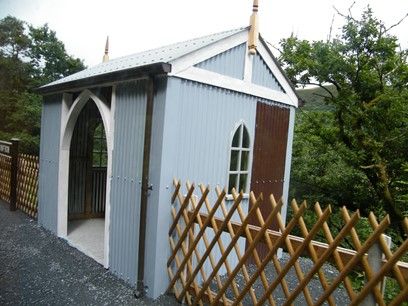
Reconstructed corrugated iron building at Rhiwfron station
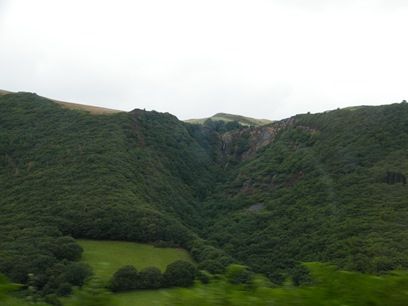
Level fawr lead mine across the valley - an aerial ropeway transported materials between the mine and Rhiwfron station
With the change of ownership, goods services also stopped, and the branch from Aberystywth station to the harbour was closed. Services were stopped during the Second World War (however started again in July 1945 before the war with Japan was over), and after passing to British Railways in 1948 with the nationalisation of the railways little changed - in fact after 1968 when standard gauge steam locomotives were all withdrawn, the three 1923 built Vale of Rheidol 2-6-2T's were the only British Rail steam locomotives, and even received the British Rail blue livery with white 'double arrow' logo on the side tanks. The line continued with British Rail until 1989 when it was privatised, and the railway continues today - unlike many other heritage railways, never having closed (apart from the stopping of services during WW2), and two of the three 1923 locomotives are still in service today, hauling carriages built in the 1920s/30s. Most of the line has unchanged since opening in the Edwardian era and combined with a visit to Devil's Bridge, or just the superb tea room at Devil's Bridge station, is a fantastic Edwardian day out.


Original 1902 corrugated iron building at Devil's Bridge station
The Vale of Rheidol Railway is a narrow gauge railway, built a gauge of 1 ft, 11 3/4 inches between the rails, originally designed to carry timber and ore from the Rheidol valley down to the sea port at Aberystwyth, however by the time the railway was nearing completion these industries were in decline in the Rheidol valley, but the huge increase in tourism in the late 19th and early 20th century gave the railway another purpose - transporting tourists up to Devil's Bridge, a very scenic part of mid-Wales, featuring a waterfall and a bridge said to have been built by the Devil himself for a local woman, so her cows could cross - the Devil planning to take the soul of the first person to cross the bridge in exchange, hoping it would be her, leading the cows - she somehow discovered this and so threw bread over the bridge, and her dog ran over, making that the first soul to cross. In reality it was built in around the 9th century - there is another bridge, built in 1753, built over the original bridge, the builders using the original bridge as scaffolding, and a 1901 iron bridge crossing the lower two.
Construction of the line started in 1901 following the Act of Parliament allowing the line to be built being granted in 1897 - two locomotives were built by Davies & Metcalfe of Manchester, who hadn't built a locomotive before (or since), but did so because Metcalfe came from Aberystwyth, the locomotives having to be capable of working the impressive gradient up to Devil's Bridge, hugging the valley side. They were 2-6-2T side tank engines, with high, thin water tanks surrounding the boiler. These were No 1 and No 2, named 'King Edward VII' and 'Prince of Wales' respectively - King Edward VII coming to the throne in 1901 following the death of his mother, Queen Victoria, and Prince of Wales being the future King George V. No 3, 'Rheidol', was built by Bagnall of Stafford in 1896 for a Brazilian plantation but was never delivered, was regauged for use on the Plynlimon and Hafan Tramway, but when this failed was regauged again for the Vale of Rheidol who purchased it in 1903.

One of the three 1923 built locomotives, No 8, almost identical to the two original Vale of Rheidol locomotives

The crew of No 8 giving attention to the locomotive after the hard climb up to Devil's Bridge
The line was opened on 22nd December 1902, and did bring about an increase in trade in the previously declining industries in the Rheidol valley, and some mines even reopened. An aerial ropeway was opened from the Level Fawr Lead Mine to Rhiwfron station. The materials from the mine, and also the timber, would be shipped down to Aberystywth for onward transportation via standard gauge railway or the sea. The line was so successful that in 1912 electric motive power was even considered - however in the same year the line came under control of the Cambrian Railway, and two years later the First World War caused a decline in traffic. At some point between 1916 and 1918 the two Davies & Metcalfe 2-6-2T locomotives were modified with bigger coal bunkers, as the ones they were fitted with were very small. After the war, the decline in local industries continued, but the tourist trade grew. At the grouping in 1923, the line came under control of the Great Western Railway, who immediately built three new locomotives that year - externally they looked almost identical to the two Davies & Metcalfe locomotives, the most obvious difference being the lack of a cab side window. Officially, only two new locomotives were built, No 7 & No 8, as these were the only two new builds authorised by the Great Western Railway, and No 9 was officially a 'rebuild' of No 2 'Prince of Wales'. In actual fact this was just an accounting exercise and No 9 was a brand new locomotive like the other two. No 1 'King Edward VII' survived for a few more years until scrapping in the 1930s.

No 9, officially a rebuild of No 2 'Prince of Wales' of 1901, and indeed also being named 'Prince of Wales', and for many years recorded in books, magazines and online as being so, however research by CC Green who published a very comprehensive book on the Vale of Rheidol Railway proved that no parts between the two locomotives would be interchangeable

Reconstructed corrugated iron building at Rhiwfron station

Level fawr lead mine across the valley - an aerial ropeway transported materials between the mine and Rhiwfron station
With the change of ownership, goods services also stopped, and the branch from Aberystywth station to the harbour was closed. Services were stopped during the Second World War (however started again in July 1945 before the war with Japan was over), and after passing to British Railways in 1948 with the nationalisation of the railways little changed - in fact after 1968 when standard gauge steam locomotives were all withdrawn, the three 1923 built Vale of Rheidol 2-6-2T's were the only British Rail steam locomotives, and even received the British Rail blue livery with white 'double arrow' logo on the side tanks. The line continued with British Rail until 1989 when it was privatised, and the railway continues today - unlike many other heritage railways, never having closed (apart from the stopping of services during WW2), and two of the three 1923 locomotives are still in service today, hauling carriages built in the 1920s/30s. Most of the line has unchanged since opening in the Edwardian era and combined with a visit to Devil's Bridge, or just the superb tea room at Devil's Bridge station, is a fantastic Edwardian day out.
One of the original, albeit much rebuilt, wagons
Overview of Devil's Bridge station
Views of the Vale of Rheidol from the railway
Sunday 6 October 2013
Fowler D2 Class Steam Roller 'Lord Kitchener', 1901
Built by Fowler of Leeds in 1901, this is D2 Class single cylinder, 12 ton steam roller, works number 9005 and named 'Lord Kitchener', registered on the roads as HR 3582. It was supplied new to W Rawlings & Sons who used it until the 1950s.
Thursday 3 October 2013
Tuesday 1 October 2013
Wolseley Type M5, 1912
This beautiful large Wolseley Limousine is an M5 model, built in 1912 and delivered to the Shuttleworth Family in July 1912 - it is fitted with a 24hp in-line six cylinder engine, giving the car a top speed of 50mph despite the heavy coach built body, and cost the Shuttleworth's £803 and 15 shillings. As can be seen it is a fantastic example of a prestigious motor car of the period with no expense spared in the manufacture.
Subscribe to:
Posts (Atom)
